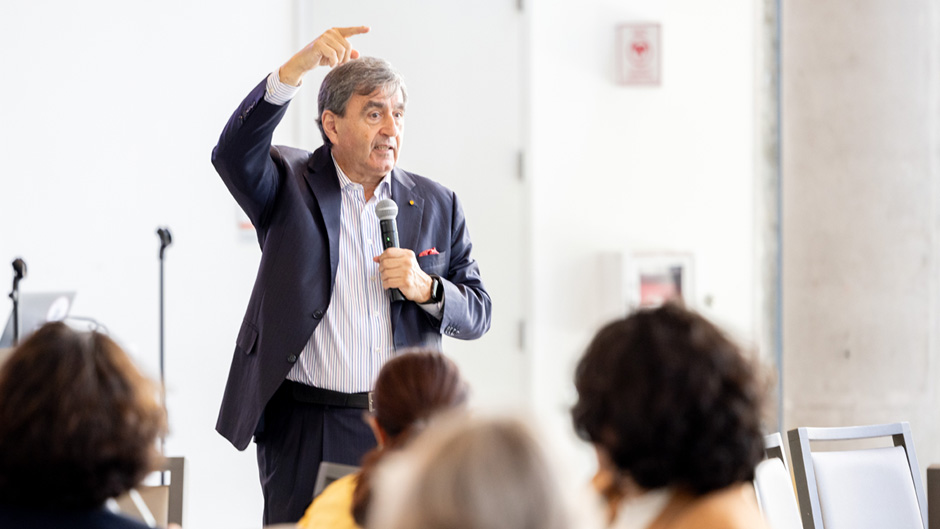When Eric Mazur was a young professor starting out at Harvard University, he happily began lecturing to his physics students without giving it much thought.
But years later, Mazur began to wonder if his students could really apply that knowledge beyond exams. When he learned about a test given by another physics professor where Newton’s law of force had to be applied to a real-life problem—in this case, a car accident—he was surprised that most students got it wrong.
After giving his own students the same exam, it confirmed his suspicion.
“That experience made me realize education is not just about transfer of information, but it’s also about assimilation of that information, so you can apply it in different contexts,” Mazur told a crowd of more than 80 University of Miami faculty members last week at the 10th annual Faculty Showcase, hosted by the University’s Platform for Excellence in Teaching and Learning (PETAL).
During the next class, Mazur decided to review the exam and challenged his students to collaborate with their peers to arrive at an answer. What he observed changed his perspective on teaching.
“That moment was the burst I needed,” said Mazur. “I came out of that session and thought that is how I should teach. I should teach by questioning. So the next day I flipped my classroom. I put a problem on the board and gave them time to think. Then I said, ‘Find a neighbor near you that does not have the same answer.’”
This strategy encouraged students to apply their knowledge, which ultimately helped them retain information better in the future, Mazur said. That incited his research into education and learning, where Mazur is now considered a top science education innovator for developing peer-to-peer instructional strategies, as well as the idea of the flipped classroom, where students read course content at home and apply their learning through assignments or discussions in class.

Mazur, the Balkanski Professor of Physics and Applied Physics at Harvard where he has been teaching for 40 years, was the keynote speaker at the Faculty Showcase. But he will also be back on campus in the spring, as the inaugural Ilene M. Dresner Presidential Distinguished Scholar. Funded by the Ilene M. Dresner Endowed Fund for Educational Innovation, Mazur will lead a faculty learning community, where 15 faculty members will work closely with him to redesign their classes and incorporate new active learning methods. In addition, all faculty can join Mazur in a virtual reading group, and in March and April, he will offer in-person workshops open to all faculty members, a seminar for physics faculty members, and a larger conversation with academic leaders on strategies for reimagining how the University evaluates teaching.
“We have to think creatively about how to engage students to determine how and if they are learning,” said Kathi Kern, senior vice provost of education, who has been using Mazur’s strategies for many years in her American history and religion courses. “We wanted to focus on ways to get students more involved in their learning, and Mazur has been a scholar in this field for three decades, so he is an inspiring force.”
Mazur has also developed technology tools for education like the Perusall platform, which allows students to make notes and ask questions while reading the course content. Since these annotations are shared with the instructor and their classmates, this is what Mazur uses to develop his questions for the following class.
Yet, there were many other teaching strategies on display at the Faculty Showcase.
Many University faculty members are employing artificial intelligence (AI) tools in their classes, such as Derin Ural, a professor of practice in civil engineering, who created two chatbots to help answer questions about course content for two of her classes that cover risk management and resilience and another on geotechnical engineering.
“As a faculty member, I love learning new things and feel this is a great way to move into the future,” she said. “I also loved learning that this chatbot was transformative for one of my students who works full time and cannot attend office hours to ask questions.”
In addition, lecturer Thomas Pear is using AI tools like Adobe Firefly to create graphic novels that are relatable for his students, who are learning English as a second language while navigating college. The virtual books offer grammar lessons while simultaneously teaching students about American culture, along with a splash of Hurricanes knowledge.
And researchers in the School of Law developed an AI-powered platform called ClassInsight to give instructors real-time feedback on students’ comprehension of a given topic. Presented by Or Cohen Sasson, a lecturer in law and technology, the platform also offers individual feedback from the instructor to students about their understanding and performance in class.
The showcase wrapped up with an interactive theater presentation about covering challenging topics in class.
“We are thrilled to have so many wonderful faculty share their innovative class tools and teaching ideas this year and hope this was helpful for everyone who attended,” said Miriam Lipsky, director of PETAL and adjunct lecturer in the School of Education and Human Development. “We look forward to seeing more faculty at our events throughout the year.”

